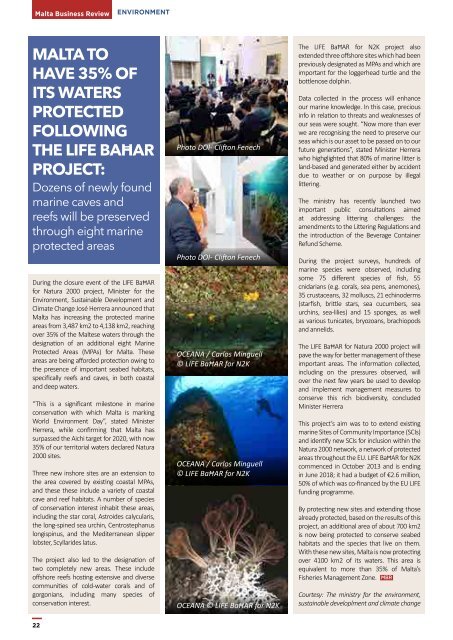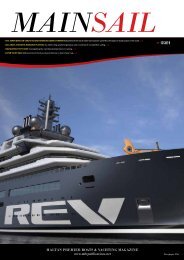MBR_ISSUE 42_LowRes
You also want an ePaper? Increase the reach of your titles
YUMPU automatically turns print PDFs into web optimized ePapers that Google loves.
Malta Business Review<br />
ENVIRONMENT<br />
MALTA TO<br />
HAVE 35% OF<br />
ITS WATERS<br />
PROTECTED<br />
FOLLOWING<br />
THE LIFE BAĦAR<br />
PROJECT:<br />
Dozens of newly found<br />
marine caves and<br />
reefs will be preserved<br />
through eight marine<br />
protected areas<br />
During the closure event of the LIFE BaĦAR<br />
for Natura 2000 project, Minister for the<br />
Environment, Sustainable Development and<br />
Climate Change José Herrera announced that<br />
Malta has increasing the protected marine<br />
areas from 3,487 km2 to 4,138 km2, reaching<br />
over 35% of the Maltese waters through the<br />
designation of an additional eight Marine<br />
Protected Areas (MPAs) for Malta. These<br />
areas are being afforded protection owing to<br />
the presence of important seabed habitats,<br />
specifically reefs and caves, in both coastal<br />
and deep waters.<br />
“This is a significant milestone in marine<br />
conservation with which Malta is marking<br />
World Environment Day”, stated Minister<br />
Herrera, while confirming that Malta has<br />
surpassed the Aichi target for 2020, with now<br />
35% of our territorial waters declared Natura<br />
2000 sites.<br />
Three new inshore sites are an extension to<br />
the area covered by existing coastal MPAs,<br />
and these these include a variety of coastal<br />
cave and reef habitats. A number of species<br />
of conservation interest inhabit these areas,<br />
including the star coral, Astroides calycularis,<br />
the long-spined sea urchin, Centrostephanus<br />
longispinus, and the Mediterranean slipper<br />
lobster, Scyllarides latus.<br />
The project also led to the designation of<br />
two completely new areas. These include<br />
offshore reefs hosting extensive and diverse<br />
communities of cold-water corals and of<br />
gorgonians, including many species of<br />
conservation interest.<br />
Photo DOI- Clifton Fenech<br />
Photo DOI- Clifton Fenech<br />
OCEANA / Carlos Minguell<br />
© LIFE BaĦAR for N2K<br />
OCEANA / Carlos Minguell<br />
© LIFE BaĦAR for N2K<br />
OCEANA © LIFE BaĦAR for N2K<br />
The LIFE BaĦAR for N2K project also<br />
extended three offshore sites which had been<br />
previously designated as MPAs and which are<br />
important for the loggerhead turtle and the<br />
bottlenose dolphin.<br />
Data collected in the process will enhance<br />
our marine knowledge. In this case, precious<br />
info in relation to threats and weaknesses of<br />
our seas were sought. “Now more than ever<br />
we are recognising the need to preserve our<br />
seas which is our asset to be passed on to our<br />
future generations”, stated Minister Herrera<br />
who highglighted that 80% of marine litter is<br />
land-based and generated either by accident<br />
due to weather or on purpose by illegal<br />
littering.<br />
The ministry has recently launched two<br />
important public consultations aimed<br />
at addressing littering challenges: the<br />
amendments to the Littering Regulations and<br />
the introduction of the Beverage Container<br />
Refund Scheme.<br />
During the project surveys, hundreds of<br />
marine species were observed, including<br />
some 75 different species of fish, 55<br />
cnidarians (e.g. corals, sea pens, anemones),<br />
35 crustaceans, 32 molluscs, 21 echinoderms<br />
(starfish, brittle stars, sea cucumbers, sea<br />
urchins, sea-lilies) and 15 sponges, as well<br />
as various tunicates, bryozoans, brachiopods<br />
and annelids.<br />
The LIFE BaĦAR for Natura 2000 project will<br />
pave the way for better management of these<br />
important areas. The information collected,<br />
including on the pressures observed, will<br />
over the next few years be used to develop<br />
and implement management measures to<br />
conserve this rich biodiversity, concluded<br />
Minister Herrera<br />
This project’s aim was to to extend existing<br />
marine Sites of Community Importance (SCIs)<br />
and identify new SCIs for inclusion within the<br />
Natura 2000 network, a network of protected<br />
areas throughout the EU. LIFE BaĦAR for N2K<br />
commenced in October 2013 and is ending<br />
in June 2018; it had a budget of €2.6 million,<br />
50% of which was co-financed by the EU LIFE<br />
funding programme.<br />
By protecting new sites and extending those<br />
already protected, based on the results of this<br />
project, an additional area of about 700 km2<br />
is now being protected to conserve seabed<br />
habitats and the species that live on them.<br />
With these new sites, Malta is now protecting<br />
over 4100 km2 of its waters. This area is<br />
equivalent to more than 35% of Malta’s<br />
Fisheries Management Zone. <strong>MBR</strong><br />
Courtesy: The ministry for the environment,<br />
sustainable developlment and climate change<br />
22

















